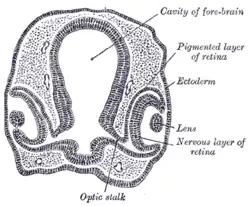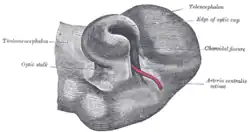Optic stalk
| Optic stalk | |
|---|---|
 Transverse section of head of chick embryo of fifty-two hours’ incubation. | |
 Optic cup and choroidal fissure seen from below, from a human embryo of about four weeks. (Optic stalk labeled at center left.) | |
| Details | |
| Carnegie stage | 14 |
| Identifiers | |
| Latin | pedunculus opticus |
| TE | stalk_by_E5.14.3.4.2.2.6 E5.14.3.4.2.2.6 |
| Anatomical terminology | |
The optic vesicles project toward the sides of the head, and the peripheral part of each expands to form a hollow bulb, while the proximal part remains narrow and constitutes the optic stalk.[1][2]
Closure of the choroidal fissure in the optic stalk occurs during the seventh week of development. The former optic stalk is then called the optic nerve.[3] In short, the optic stalks are the structures that precede the optic nerves embryologically.
References
![]() This article incorporates text in the public domain from page 1001 of the 20th edition of Gray's Anatomy (1918)
This article incorporates text in the public domain from page 1001 of the 20th edition of Gray's Anatomy (1918)
- ↑ Hosseini, Hadi S.; Beebe, David C.; Taber, Larry A. (2014). "Mechanical effects of the surface ectoderm on optic vesicle morphogenesis in the chick embryo". Journal of Biomechanics. 47 (16): 3837–3846. doi:10.1016/j.jbiomech.2014.10.018. PMC 4261019. PMID 25458577.
- ↑ Hosseini, Hadi S.; Taber, Larry A. (2018). "How mechanical forces shape the developing eye". Progress in Biophysics and Molecular Biology. 137 (16): 25–36. doi:10.1016/j.pbiomolbio.2018.01.004. PMC 6085168. PMID 29432780.
- ↑ Kaplan Qbook - USMLE Step 1 - 5th edition - page 55
External links
- eye-012—Embryo Images at University of North Carolina
- Overview at vision.ca
This article is issued from Offline. The text is licensed under Creative Commons - Attribution - Sharealike. Additional terms may apply for the media files.